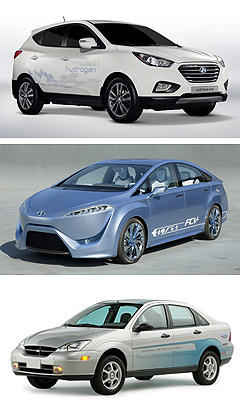Auto superpowers team up on hydrogen
BY MIKE COSTELLO | 29th Jan 2013

The three-way agreement will see each party invest equally in a project that aims to “jointly develop a common fuel cell electric vehicle system while reducing investment costs associated with the engineering of the technology” through economies of scale.
In a joint statement, the trio of automotive heavy hitters said the collaboration across three continents – Ford from the US, Nissan from Japan and Mercedes-Benz parent Daimler from Germany – would help define global specifications and component standards ahead of a wider roll-out of the technology.
The partners also claim this latest joint venture into the relatively immature fuel cell market will send a “clear signal” to suppliers, policy makers and the wider industry to encourage the further development worldwide of FCEV infrastructure – including hydrogen fuelling stations.
Hydrogen filling stations remain a relative rarity, although a small number are in operation in the US state of California, Germany, Japan and several parts of Scandinavia.

News of the three-way partnership comes a week after Toyota and BMW announced a similar agreement to co-develop a range of technologies, including a new-generation fuel-cell system. Toyota had previously said it would have a production fuel cell vehicle on the road by 2015.
Fellow automotive giant Hyundai this month became the first car-maker to commence commercial production of an FCEV when the ix35 SUV-based fuel cell vehicle began rolling out of its plant in Ulsan, South Korea.
The latest three-way strategic cooperation is an extension of an existing agreement between Daimler AG and the Renault-Nissan Alliance to jointly develop engines and transmissions. However, it appears Renault will not contribute to the new fuel-cell partnership.
Fuel cell vehicles are powered by a chemical reaction between hydrogen (stored on board under pressure as a liquid) and oxygen from the air, with water (H2O) the only emission. Electricity is generated in what is known as a fuel cell ‘stack’.
The agreement will see the creation of a common fuel cell stack for three “highly differentiated, separately branded FCEVs” as early as 2017.
Each company says FCEVs will complement, rather than supplant, existing zero-emission electric vehicles.
Speaking at the signing of the agreement this week in Yokohama, Japan, Nissan board member and executive vice-president Mitsuhiko Yamashita described FCEVs as “the obvious next step to complement today’s battery electric vehicles”.
Ford vice-president of global product development Raj Nair said the collaboration between the three automotive giants would speed up the development of more advanced FCEV technology and, thanks to the larger production volumes, would also make it more affordable for customers.
“We will all benefit from this relationship as the resulting solution will be better than any one company working alone,” he said.
Daimler AG board of management member Thomas Weber said: “We are convinced that FCEVs will play a central role for zero-emission mobility in the future. Thanks to the high commitment of all three partners, we can put fuel cell e-mobility on a broader basis.”All three members of the joint venture have dabbled with FCEV trials in the past. Mercedes-Benz produced 200 B-Class F-Cell lease vehicles in 2009, Nissan revealed a wild fuel cell SUV concept called the Terra last September, and Ford began testing its Focus ‘FCV’ in 2005.